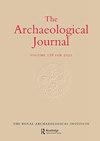Contact, concord and conquest: Britons and Romans at Scotch Corner
IF 0.8
0 ARCHAEOLOGY
引用次数: 2
Abstract
historical models and particular exemplars, Silvester instead situates analysis in the datacentric results of a study in 2015 by the Gwynedd Archaeological Trust. The result is an important and potentially seminal analysis that highlights differences and divergences at a local and regional level. This theme of locality is further adopted in David Austin’s contribution analysing in detail the development of an estate and landscape surrounding the Abbey of Strata Florida in Ceredigion. Subsequently, Rhiannon Comeau demonstrates the origin of the thirteenth-century term In rodwallis in the inter-related practices and seasonal practices of land-use in pre-Conquest Wales through a detailed study of the lordship of Cemais. Continuing this theme of demonstrating the enduring value of focused analyses of specific localities, Andy Seaman emphasizes the value of the Llandaff charters for understanding landscape, exploitation and political dynamics in the case of the estate surrounding Llangorse. Demonstrating how different a picture they present to eighteenthand nineteenth-century accounts of agricultural norms, Seaman also expertly elucidates the operation of a major royal and ecclesiastical landscape. Tudor Davis thereafter marries concerns for the locality, with a regional and national focus, demonstrating temporal and spatial variation across Wales from a palaeoecological standpoint. This exceptional work of synthesis is perhaps the most significant, original and comprehensive piece of research within this excellent volume, challenging many of the dominant narratives surrounding agricultural expansion, decline and contraction. Wrapping up the volume, Andrew Fleming presents a thought-provoking and powerful discussion of the need to consider both continuity and change against a range of scales, emphasizing how powerful a lens this is for the analysis of the nexus of agriculture and landscape in Wales. As a whole, this volume is an exceptionally important statement of the potential of focused local and regional scale analysis to transform understandings of the nature of agricultural practice, and its significance in wider social, political and cultural developments. The contributions complement each other excellently, and together describe a cohesive overview of interest to those studying Wales, but also more broadly to students of landscape, agriculture and medieval society elsewhere.接触、和谐与征服:苏格兰角的不列颠人和罗马人
在历史模型和特定范例中,西尔维斯特将分析置于2015年格温内德考古信托基金会的一项以数据为中心的研究结果中。其结果是一个重要的和潜在的开创性分析,突出了地方和区域一级的差异和分歧。在David Austin的贡献中进一步采用了这种地方性的主题,详细分析了Ceredigion的Strata Florida修道院周围的庄园和景观的发展。随后,Rhiannon Comeau通过对Cemais领主的详细研究,论证了13世纪“In rodwallis”一词在征服前威尔士土地使用的相互关联的实践和季节性实践中的起源。安迪·希曼继续阐述了对特定地区进行集中分析的持久价值这一主题,强调了兰格夫宪章在理解兰格夫周边地区的景观、开发和政治动态方面的价值。希曼还熟练地阐明了主要的王室和教会景观的运作,展示了它们与18世纪和19世纪农业规范的不同之处。此后,都铎·戴维斯将对地方的关注与区域和国家的关注结合起来,从古生态学的角度展示了威尔士的时空变化。这本杰出的综合著作可能是这本优秀著作中最重要、最原始、最全面的研究作品,它挑战了许多围绕农业扩张、衰退和收缩的主流叙事。最后,安德鲁·弗莱明提出了一个发人深省和有力的讨论,需要考虑连续性和变化的范围内的尺度,强调如何强大的一个镜头,这是对农业和景观在威尔士的关系的分析。作为一个整体,这卷是一个特别重要的潜力集中的地方和区域规模分析,以改变农业实践的性质的理解,其意义在更广泛的社会,政治和文化发展的声明。这些贡献非常好地相互补充,并共同描述了对那些研究威尔士的人感兴趣的有凝聚力的概述,但也更广泛地为其他地方的景观,农业和中世纪社会的学生提供了兴趣。
本文章由计算机程序翻译,如有差异,请以英文原文为准。
求助全文
约1分钟内获得全文
求助全文

 求助内容:
求助内容: 应助结果提醒方式:
应助结果提醒方式:


